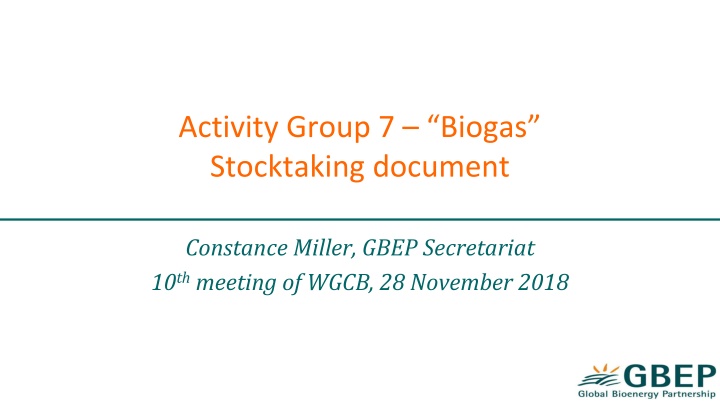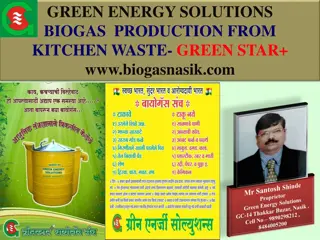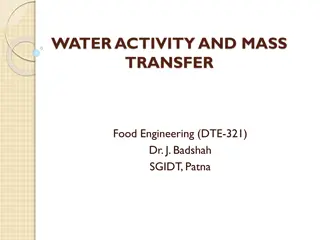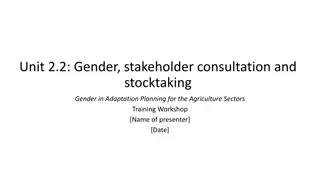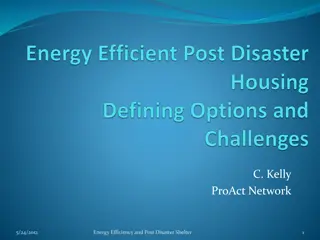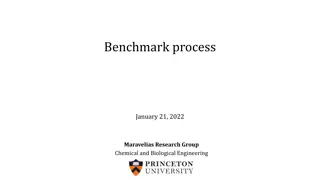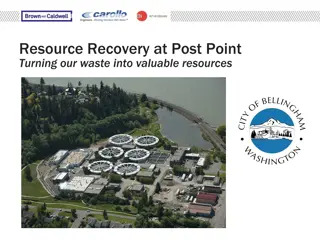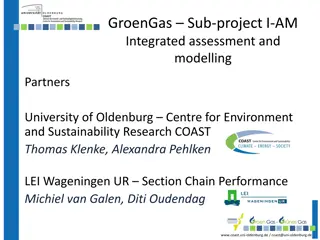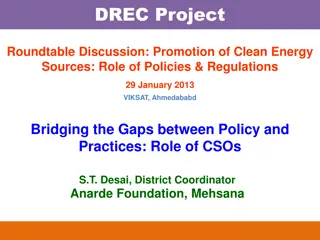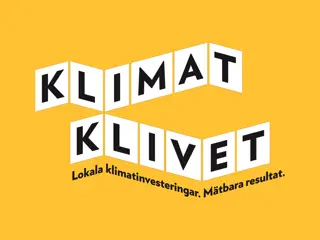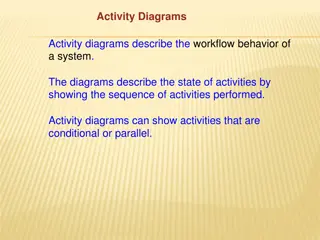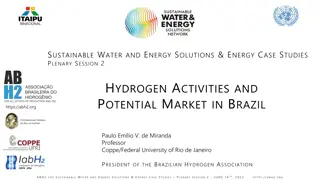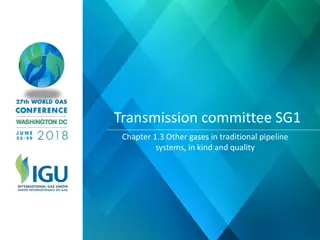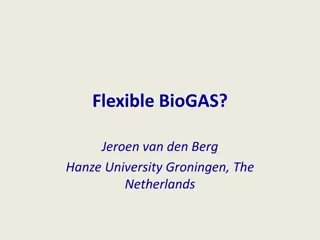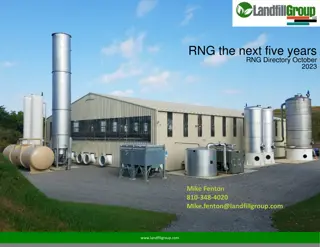Biogas Stocktaking Document for Activity Group 7
Established in November 2017, Activity Group 7 focuses on biogas. The GBEP Secretariat is tasked with preparing a stocktaking document highlighting the group's progress. Constance Miller from the Secretariat presented this at the 10th meeting of WGCB in November 2018.
Download Presentation

Please find below an Image/Link to download the presentation.
The content on the website is provided AS IS for your information and personal use only. It may not be sold, licensed, or shared on other websites without obtaining consent from the author.If you encounter any issues during the download, it is possible that the publisher has removed the file from their server.
You are allowed to download the files provided on this website for personal or commercial use, subject to the condition that they are used lawfully. All files are the property of their respective owners.
The content on the website is provided AS IS for your information and personal use only. It may not be sold, licensed, or shared on other websites without obtaining consent from the author.
E N D
Presentation Transcript
Activity Group 7 Biogas Stocktaking document Constance Miller, GBEP Secretariat 10thmeeting of WGCB, 28 November 2018
Background AG7 formally established by WGCB November 2017 Stocktaking document to be prepared by GBEP Secretariat to inform the future activities of this AG with the aims of: Understanding sustainable value chains for food and energy security in different contexts Demonstrating effective systems, challenges and opportunities Understanding the perceptions of stakeholders on the factors important for success of biogas value chains at a range of scales
Abstract The paper analyses the factors that contribute to the success (or failure) of biogas operations or projects in different regions of the world. The analysis is carried out using SWOT analysis; this approach seeks to identify the strengths, weaknesses, opportunities and threats of a particular business model through discussions with relevant stakeholders. The stocktaking paper is based on the work of the GBEP Secretariat along with GBEP Partners and Observers during the GBEP Bioenergy Weeks (2017, 2018 and 2019). As such, its focus will be on Africa, Latin America and the Caribbean, and Asia. It is to be used as a preliminary background document to guide the focus of the Activity Group 7 on Biogas (AG7) of the Working Group on Capacity Building (WGCB).
Outline Introduction to biogas Methodology of SWOT analysis in three regions Africa Latin America and the Caribbean Asia Results and discussion Limitations and future research Conclusions
SWOT Analysis Strengths Weaknesses Certain inherent qualities that give a business model comparative advantage, ability to add value to or competitive edge over a competitor. Internal factors that are unfavourable in achieving the objectives of a business model and that place the business model at comparative disadvantage. Internal Aspects External Aspects Opportunities Threats Advantages that exist within the ecosystem, external to the business model but available to all players within the industry/environment of which it takes benefits from to increase its value addition. External risks that the business model is exposed to; factors from the external environment of the business model that poses danger in achieving system objectives. Source: adapted from Team FME (2013)
Africa SWOT analysis carried out as part of the 5th Bioenergy Week in Ghana, 2017 Large-scale and small-scale considered separately (no consideration of medium-scale) Large-scale survey on relevant strengths, weaknesses, opportunities and threats administered to selected stakeholders with expert knowledge Small-scale focus group at Bioenergy Week 2017 to identify relevant strengths, weaknesses, opportunities and threats these were ranked using an Analytical Hierarchy Process (AHP)
Africa - Large-scale biogas - Results Strengths Weaknesses Opportunities Threats Added value for existing business value chains Improve the livelihood of local population Existence of incentives for production of renewable energy Development of new enterprise for collecting and selling digestate to farmers as fertilizer substitute Building capacities Increased access to energy for local populations Socio-economic development Development of new enterprise for collecting, transporting and selling agro-industrial waste as feedstock. (Creation of consortium) Technicians for optimizing plant performance considering the locally available feedstock Skilled employees for checking plant performance Development of new training activities: teachers and educational experts Reduced number of sanitation- related diseases and sicknesses due to poor waste management Reduces the use of other type of fuel (e.g. fossil fuel, wood) and the related environmental impacts Improved community sanitation Increase crop yield Cut down energy costs through self-provision Increase soil quality (soil organic matter content) and fight soil depletion Effective use of agro-industrial waste: easy and healthy waste disposal Lack of technology know-how in plant management High cost for collecting and transporting the feedstock Low financial returns Limited financial access for initial investment High initial investment for plant setting Lack of know-how in digestate utilization Lack of know-how for plant maintenance High maintenance cost Lack of use for heat generated No regular feedstock supply (i.e. because of seasonality) Lack of data on feedstock availability, e.g. types, quantity available, seasons and locations Lack and/or inadequacy of means of transport for feedstock and by- product Availability and affordability of feedstock in the long term High cost of capital Low acceptance from local population Small scale agriculture is not adapted to large scale technology Competition with alternative uses of feedstock (e.g. fuel building material etc.) Possibility of accidental emissions of methane in the atmosphere Lack of understanding of technology among financial institutions Policy and administrative barriers Artificially low energy prices due to fossil fuel subsidies (e.g. coal)
Africa - Small-scale biogas - Results Rank Strengths Weaknesses Opportunities Threats Lack of knowledge on return on investment by investors and providers of capital (leading to lack of financial resources) Access to modern, clean cooking energy. High initial capital requirements (high cost of construction) 1 Commercial by-products Improve sanitation/health (through better waste management and reduced indoor air pollution). Technology transfer and availability Uncertainty of feedstock availability in the long term 2 Cultural unacceptability Lack of skills and knowledge in the construction of the biogas system (technical know-how) Availability of feedstock and improved waste disposal. Comparative cost of other energy sources (e.g. LPG) 3 Availability of pre-finance By-products (digestate) increase agricultural yields through use as fertilizer, increasing income. Lack of ability to identify financial resources (loans) Incentives for climate change mitigation 4 Low water availability Lack of technical knowledge and skills for operation and maintenance Requirement for constant monitoring and evaluation Ease of transfer of technology know-how Lack of knowledge and social non- acceptance (due to culture/beliefs) 5 Incentives for forest stewardship Save family time (e.g. in wood collection). Trade barriers on imports of biodigesters 6 No cost for dislodging
Latin America and the Caribbean SWOT analysis carried out around the 6th Bioenergy Week in Argentina, 2018 Biogas at household level and for productive uses (industrial and farm level) clearly defined and considered separately Factors for the SWOT identified by interviews with key experts and from secondary research AHP still to be carried out in order to rank the factors
Latin America and the Caribbean Preliminary findings Biogas at household level Strengths Flexibility of feedstocks (e.g. manure sheep, cow and llama, quinoa stalk, totora and o-macrophytes from Lake Titicaca, slaughterhouse and other fruit and vegetable waste) Digestate good for use in family farming can be used instead of chemical fertilisers nutrients are in mineral form so more easily absorbed by plant roots digestate is more homogeneous and can penetrate soil faster than manure reduces weed seed germination and odours compared to dung Reduction of indoor emissions (through reduced use of fuelwood for cooking and heating) Less time collecting fuelwood Weaknesses Lower biogas production at high altitudes (due to lower temperature) No mixing in typical tubular digesters (lower biogas production) No heating to maintain temperature (lower biogas production) Lack of an appropriate management model after implementation due to lack of knowledge on use and maintenance High capital costs of construction (Bond & Templeton, 2011; Garf et al., 2016) Difficulty with accessing microcredit loans as not seen as an investment that easily yields profits (Garwood, 2010) High costs of maintenance Digestate requires post-treatment for final use or disposal due to presence of pathogens (Castro et al., 2017) Opportunities Increased future research on potential effects of digestate utilisation on crop fertilisation (could lead to increased uptake) Low-carbon energy Reduces deforestation (clean fuel to substitute fuelwood) Controls environmental pollution by treating wastewater and organic wastes Threats Lack of social acceptance of biogas technology both due to cultural cooking habits and distaste at using manure for cooking (Garwood, 2010) Subsidies for LPG (or other alternative fuels) and free use of firewood dicentivises investment in biogas (Martiniello, 2017) Subsidies for biogas increase failure rate due to lack of ownership Lack of businesses that manufacture, install and service small- scale biodigesters (Garwood, 2010) Cattle management practices that involve extensive grazing (Hern ndez et al., 2012)
Latin America and the Caribbean Preliminary findings Biogas at household level Strengths Flexibility of feedstocks Digestate good for use in family farming can be used instead of chemical fertilisers nutrients are in mineral form so more easily absorbed by plant roots digestate is more homogeneous and can penetrate soil faster than manure reduces weed seed germination and odours compared to dung Reduction of indoor emissions (through reduced use of fuelwood for cooking and heating) Less time collecting fuelwood
Latin America and the Caribbean Preliminary findings Biogas at household level Weaknesses Low biogas production due to: high altitudes (due to lower temperature) No mixing in typical tubular digesters No heating to maintain temperature Lack of an appropriate management model after implementation due to lack of knowledge on use and maintenance High capital costs of construction (Bond & Templeton, 2011; Garf et al., 2016) Difficulty with accessing microcredit loans as not seen as an investment that easily yields profits (Garwood, 2010) High costs of maintenance Digestate requires post-treatment for final use or disposal due to presence of pathogens (Castro et al., 2017)
Latin America and the Caribbean Preliminary findings Biogas at household level Opportunities Increased future research on potential effects of digestate utilisation on crop fertilisation (could lead to increased uptake) Low-carbon energy Reduces deforestation (clean fuel to substitute fuelwood) Controls environmental pollution by treating wastewater and organic wastes
Latin America and the Caribbean Preliminary findings Biogas at household level Threats Lack of social acceptance of biogas technology both due to cultural cooking habits and distaste at using manure for cooking (Garwood, 2010) Subsidies for LPG (or other alternative fuels) and free use of firewood discentivises investment in biogas (Martiniello, 2017) Subsidies for biogas increase failure rate due to lack of ownership Lack of businesses that manufacture, install and service small- scale biodigesters (Garwood, 2010) Cattle management practices that involve extensive grazing (Hern ndez et al., 2012)
Latin America and the Caribbean Preliminary findings Biogas for productive use Strengths Digestate A good source of soil organic amendment, compost and biofertilizer that can be sold for income generation (Aso et al., 2018) Lower leaching from digestate than from animal manure (Dragicevic et al., 2017; Lansing et al., 2008) Low-cost electricity generation Reductions in costs for industries' self-consumption of power from biogas plant Treatment of OFMSW is economically attractive (Alem n-Nava et al., 2015) and leads to GHG reductions (Piacentini & Vega, 2017) Technology is readily available GHG emission mitigation CH4emission reductions from decomposition of animal/human wastes, and agroindustry residues N2O emission reductions from biological oxidation of ammonia and reduced demand for synthetic fertiliser (Bond & Templeton, 2011) Weaknesses Competing commercial uses of feedstock (Hern ndez et al., 2012) Need for multidisciplinary skill set to follow biogas projects from conception to operation (Hern ndez et al., 2012) Complex supply chains (Alem n-Nava et al., 2015) Electricity generation from biogas is not an efficient process thus reducing the sustainability (Ciotolaet al., 2011) Opportunities Integrated waste management services (L ngvistet al., 2018) Creates jobs through development of new investments, facilities and projects (Castro et al., 2015) Access to the Clean Development Mechanism (CDM) (Hern ndez et al., 2012) Access to carbon markets Can be used in a smart grid context (Alem n-Nava et al., 2015) Possibilities for Power Purchase Agreements (PPAs) Availability of underexploited feedstocks (Gutti rez-Castro et al., 2015) Threats Lack of engagement by private and public sectors in sustainability (L ngvistet al., 2018) Alternative fuels Lock-in effect due to fossil fuel subsidies (L ngvistet al., 2018) Free use of firewood discentivisesinvestment in biogas (Martiniello, 2017) Lack of subsidies for biogas (L ngvistet al., 2018) Requires system reconfiguration (L ngvistet al., 2018) Limited access to financial capital as social and environmental externalities are not taken into account in financial analysis by investors (Hern ndez et al., 2012; INDAP & GORE, 2016) Instability of carbon credits (Alem n-Nava et al., 2015) Predatory or inhibitory competition between renewable energy systems, e.g. Colombia (Alem n-Nava et al., 2015) Cattle management practices that involve extensive grazing (Hern ndez et al., 2012) No market value for digestate (Martiniello, 2017)
Latin America and the Caribbean Preliminary findings Biogas for productive use Strengths Digestate A good source of soil organic amendment, compost and biofertilizer that can be sold for income generation (Aso et al., 2018) Lower leaching from digestate than from animal manure (Dragicevic et al., 2017; Lansing et al., 2008) Low-cost electricity generation Reductions in costs for industries' self-consumption of power from biogas plant Treatment of OFMSW is economically attractive (Alem n-Nava et al., 2015) and leads to GHG reductions (Piacentini & Vega, 2017) Technology is readily available GHG emission mitigation CH4emission reductions from decomposition of animal/human wastes, and agroindustry residues N2O emission reductions from biological oxidation of ammonia and reduced demand for synthetic fertiliser (Bond & Templeton, 2011)
Latin America and the Caribbean Preliminary findings Biogas for productive use Weaknesses Competing commercial uses of feedstock (Hern ndez et al., 2012) Need for multidisciplinary skill set to follow biogas projects from conception to operation (Hern ndez et al., 2012) Complex supply chains (Alem n-Nava et al., 2015) Electricity generation from biogas is not an efficient process thus reducing the sustainability (Ciotola et al., 2011)
Latin America and the Caribbean Preliminary findings Biogas for productive use Opportunities Integrated waste management services (L ngvist et al., 2018) Creates jobs through development of new investments, facilities and projects (Castro et al., 2015) Access to the Clean Development Mechanism (CDM) (Hern ndez et al., 2012) Access to carbon markets Can be used in a smart grid context (Alem n-Nava et al., 2015) Possibilities for Power Purchase Agreements (PPAs) Availability of underexploited feedstocks (Gutti rez-Castro et al., 2015)
Latin America and the Caribbean Preliminary findings Biogas for productive use Threats Lack of engagement by private and public sectors in sustainability (L ngvist et al., 2018) Alternative fuels Lock-in effect due to fossil fuel subsidies (L ngvist et al., 2018) Free use of firewood discentivises investment in biogas (Martiniello, 2017) Lack of subsidies for biogas (L ngvist et al., 2018) Requires system reconfiguration (L ngvist et al., 2018) Limited access to financial capital as social and environmental externalities are not taken into account in financial analysis by investors (Hern ndez et al., 2012; INDAP & GORE, 2016) Instability of carbon credits (Alem n-Nava et al., 2015) Predatory or inhibitory competition between renewable energy systems, e.g. Colombia (Alem n-Nava et al., 2015) Cattle management practices that involve extensive grazing (Hern ndez et al., 2012) No market value for digestate (Martiniello, 2017)
Next steps Survey for LAC to rank important factors for SWOT analysis and draw conclusions Regional analysis in Asia in 2019
